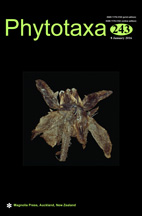Abstract
Thorough investigation of old collections is an important service to taxonomy and history of science. In this process, many old collections that may have been forgotten can be made available again for science. Recently, online databases like Tropicos (www.tropicos.org), the World checklist of selected plant families (http://apps.kew.org/wcsp/home.do) and The plant list (www.theplantlist.org) have facilitated this work (Steudel et al. 2012). It has not yet been recognized that many old collections are rich in type material. These specimens are of particular value since some collections have been destroyed (e.g. Herbarium Berolinense in World War II), and it is important to compile lists of type material from the 18th and 19th century from as many herbaria as possible. An example is the discovery of type material of Bipinnula polysyka Kraenzl. (Kränzlin 1887; Orchidaceae) in Zurich (Z & ZT) by Steudel et al. (2012). This material has been designated as lectotype of the species as it represents the only known original material (Sanguinetti et al. 2015). Additionally, a complete revision of a group can clarify nomenclatural confusion (Steudel 2012).

